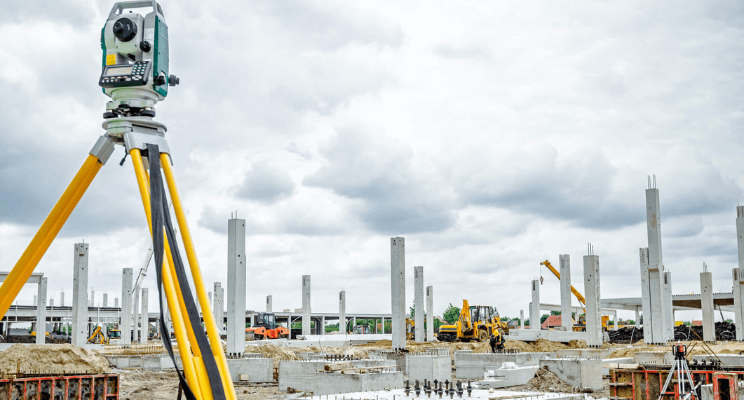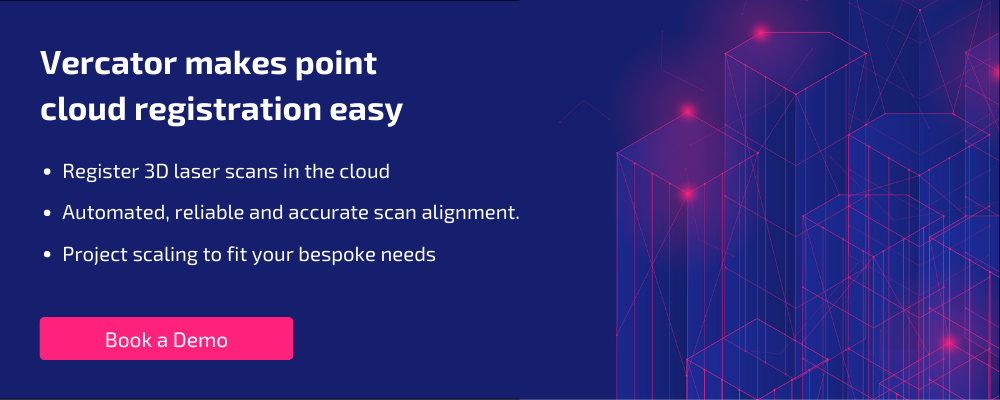How cloud-based registration could help you boost productivity by 80%

A leading survey company trialled our point cloud processing software — and the results speak for themselves
Registering point cloud data can be a complicated, time-consuming process. With outdated tools and manual input, it can significantly impact the duration, cost, and quality of projects. But with modern tools that automate this process, it is possible to save time while boosting productivity and scalability.
In this article, we’ll outline the benefits of cloud-based registration, highlighting how a leading survey company enjoyed remarkable results when it shifted from conventional tools to Vercator.
How point cloud processing works
Point cloud processing software typically identifies targets or features in the following three ways, depending on the level of automation available:
- Manual processing: Manual processing requires a human to pick common points in scans and then categorise them. This can be an incredibly repetitive, time-intensive process. And while we can generally trust people to effectively identify different features, human error still exists.
- Semi-manual processing: This is a hybrid process that combines automation and human input. An algorithm is used to automatically identify features based on certain criteria. These features are then verified by the user, who acts as the final quality control. Over time, human input can help fine-tune the algorithm to become more accurate.
- Fully automated processing: Here, the algorithm analyses the entire point cloud and detects features without human input. This is a much faster and more efficient approach that liberates human operatives from intensive, repetitive tasks.
Vercator software falls under the third example. But unlike conventional point cloud processing solutions that identify features using basic geometry from a limited subset of data, Vercator uses all points to generate features.
The benefits of cloud-based registration
Cloud-based registration offers a more efficient and effective alternative to traditional point cloud registration, allowing you to:
- Scale processing to fit any job size
- Eliminate the need for expensive software and hardware updates
- Automate the process of point cloud registration, saving you time and money
- Share workflows easily between stakeholders
How Omega Geomatics saved time and money using Vercator
Leading survey company Omega Geomatics has always tried to stay ahead of the technological curve. But back in mid-2021, they had a decision to make – invest in costly new scanning equipment, or find a way to extend the life of their existing fleet of scanners by leveraging new software designed to boost productivity.
Keen to save as much money as possible in order to invest in other parts of the business, they decided to go with the latter option. They commenced an R&D project to investigate the potential cost and time savings of software upgrades, with the aim of getting the green light from top management.
Omega’s scanning fleet included three Faro X-series scanners. Once scans were complete, their workflow involved carrying out registration via a computer either on-site or in the office. This was a fairly time-consuming process, requiring a good deal of input from a surveyor. For example, registering the scan of a small house would take up to 1.5 hours.
After researching a number of software packages, the Omega team finally settled on Vercator. Next, it was time to put it to the test during a pilot project.
Vercator Cloud in action
As a fully cloud-based solution, Vercator allows you to upload and register scans to the cloud directly from the site. This process can be performed with ease using Vercator’s dedicated mobile app.
For Omega, piecing together different scan elements was the most time-consuming and error-prone part of the registration process, as scans could become misaligned.
With the Vercator mobile app, surveyors were able to piece scans together to form a network, allowing them to verify in real-time that the registration network was correct. Once verified, the software’s algorithm linked the scans together during processing.
Clear cost and productivity savings
At the time, Omega was using Faro Scene to carry out an initial top view registration of a cluster of scans, followed by a cloud-to-cloud registration.
The team came up against issues when scanning buildings with a repetitive or uniform structure. The software simply wasn’t intelligent enough to understand which scans should be linked, increasing the risk of incorrect placements.
In such cases, the team was forced to carry out a manual registration, to ensure that the right scans were in the right places. This was a time-consuming, inefficient process that they were keen to improve.
Omega’s first Vercator test was a big success, demonstrating clear cost and productivity savings. What’s more, the level of savings was directly proportional to the size of the project — the larger the project, the more time and money they were able to save.
This gave them the go-ahead to continue using existing scanners, allowing them to save the money they would have spent on upgrading their hardware.
An 83% saving in office time
Switching to Vercator allowed Omega to save time throughout the registration process, liberating surveyors and other staff from tedious manual tasks, and allowing them to focus on more high-value work.
While the time spent on-site was roughly the same as before, Omega was able to cut office time drastically, with Vercator Cloud processing registration twice as fast as Faro Scene.
Despite a few minor tasks such as manual log-ins needed to export data, they have largely eliminated the repetitive manual tasks that were previously so costly. Altogether, Omega was able to cut office time on the pilot project by a whopping 83%.
Brett Duffield, Director at Omega Geomatics, had this to say:
“This was a significant productivity saving. And after several supervised tests, the software is now in full use after sustained results. As a minimum, we had previously spent 1.5 days a week processing, which is no longer required as the teams are able to process on the same day. This equates to a significant saving in fees per week, allowing us to take on more work.”
If you’d like to find out more about how Vercator can save you time and money, visit vercator.com.
Tags: Point Cloud Registration


